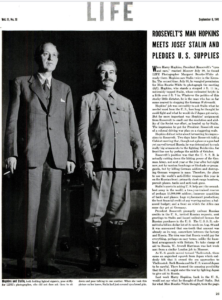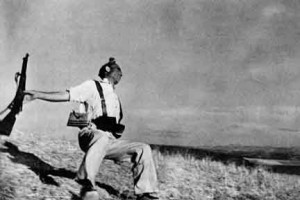Tony Vaccaro talks about combat photography in World War II on C-Span American Artifacts.
 Margaret Bourke White, (1904 – 1971) “the first American girl to drive into the Kremlin,” took photos of one of the world’s most horrific mass murderers, Joseph Stalin, and described the experience “At last I was sent for. I had no time to be nervous… Stalin is a different looking man from what I had expected. His pictures make him look tall, but he is short. His pictures make his face look plump, but it is rather lean. He looks like a man who has been stout and gotten thinner lately. He has a kind of gray and tired look… His mustache and hair have a kind of chewed up, straw-like look. He wears boots and plain khaki clothes. His hands are wrinkled. He looks like a completely strong person, immobile and unemotional…” He laughed when she dropped to her knees to get this shot.
Margaret Bourke White, (1904 – 1971) “the first American girl to drive into the Kremlin,” took photos of one of the world’s most horrific mass murderers, Joseph Stalin, and described the experience “At last I was sent for. I had no time to be nervous… Stalin is a different looking man from what I had expected. His pictures make him look tall, but he is short. His pictures make his face look plump, but it is rather lean. He looks like a man who has been stout and gotten thinner lately. He has a kind of gray and tired look… His mustache and hair have a kind of chewed up, straw-like look. He wears boots and plain khaki clothes. His hands are wrinkled. He looks like a completely strong person, immobile and unemotional…” He laughed when she dropped to her knees to get this shot.
Bourke-White was also known as the first American female war photojournalist, and having one of her photographs (the construction of Fort Peck Dam) on the cover of the first issue of Life magazine. Her photo of Mahatma Gandhi is a classic of visual communication. (Life magazine is available on Google Books and on the Time-Life website.)

SPAIN. Cordoba front. 1936. Death of a Loyalist Militiaman by Robert Capa. Magnum Photos.
Robert Capa, the war photographer who reinvented himself, is profiled in this interesting article by Eric Kim. “He captured some of the most intense wars during his time, including the Spanish Civil War (1936-39), Chinese resistance to the Japanese invasion (covered in 1938), the European theater of World War II from (1941-45), the first Arab-Israeli War (1948), and the French Indochina War (1954) and tragically passed away by stepping on a mine.
Capa also famously coined the phrase: “If your pictures aren’t good enough, you’re not close enough” and his bravery on the front-lines helped him capture some of the most intense, intimate, and emotional photos of war.

 Alfred Eisenstaedt takes a snap of an American sailor kissing a young nurse in Times Square on
Alfred Eisenstaedt takes a snap of an American sailor kissing a young nurse in Times Square on